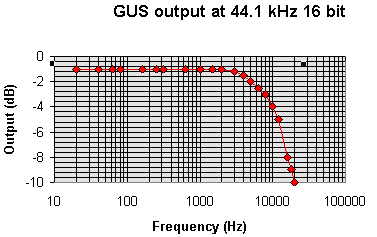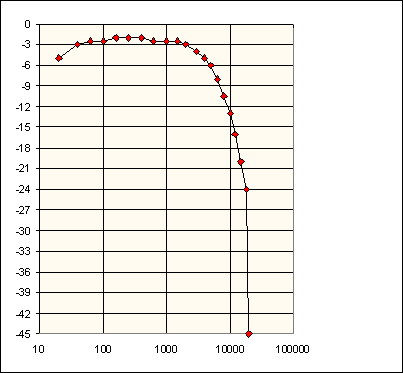Gravis Ultrasound frequency response
This page tries to show you some technical data of Gravis Ultrasound soundcard (the original version, not MAX or PnP).
Background
It very hard to get real technical data from soundcard manufacturers. All they claim is 16 bit sound at 44.1 kHz and "CD quality". Those claims do not tell much, because usually the soundcards are far from HiFi and CD palyer sound quality. They are noisy and frequency response is bad. The sound quality is usually something comparable to casette recorder. Some manufacturers like Gravis and Turtle Beach have made their cards to perform a little better that others.
Gravis Ultrasound performance data
I was curious what was the performance of my Gravis Ultasound soundcard (revision 2.4). I had seen some tests in magezines, but they had usually tested only the sound card performance in input->computer->output configuration. Because my card has only 8-bit A/D converter, the input was quite useless anyway, I was oly interested only in output quality. I found no ready made measurements, so I had to make my own.
How I made this measurement
First I lended a Nakamichi T-100 Audio Analyzer, which is a very good instrument for this kind of measurements. Then I downloaded GoldWave shareware sound editing program. I used GoldWave tools to generate the test sound signals which I played back through my Gravis Ultrasound soundcard. I connected the audio analyzer to the line output of the soundcard and did the testing play playing back sine wave signals with different frequencies and wrote down what the analyzer show out.
The results
Sample playback
I tested the sample output of Gravis ultrasound card at 44.1 kHz output sample rate and 16 bit resolution. I tested only the line output. Here are the results of the measurement in the graph below. As you can see, Gravis Ultrasound performance is very good at high frequencies. The ouput level starts to fall at about 4 kHz and it has fallen 3 dB at 10 kHz and 9 dB at 20 kHz. This performance figure is not HiFi quality.

GUS sample playback frequency response (X: dB, Y: Hz)
Line level digitizing and playback
I also tested how good GUS is in digitizing and playing back sampled data. Basic GUS has only 8 bit resolution in digitizing, so that it not useful for anything real audio processing. But for some purposes it is still useful to know the total frequency response (this is usually measured in computer magazine tests). I measured the record and output frequency response using line input an line output lines. I sended reference signal to line input, digitized it using sampling program (at 44.1 kHz sample rate) and then played it back and cheked the output level.

GUS record and playback frequency response (X: dB, Y: Hz)
Mixer frequency response
The last measurement was to measure the quality the mixed circuit in GUS. I playded sound to line input and checked what comes out of line output when the input is enabled. This information is useful to those who route some sounde source (CD-player or CD-ROM) through their soundcard mixer.

GUS mixer frequency response (X: dB, Y: Hz)
Noise levels
Gravis Ultrasound has always said to be quiet card, which means that it does make much noise by itself. To see those figures I tested the soundcard with Nakamichi audio analyzer. I set the soundcard output level so that the card gives 0.78 Vrms output level (0 dB reference) and then I measured the noisel levels when the card dos not play back anything. I got noise levels of -85 dB A-weighted and -70 dB in linear scale. Those are not bad figures for cheap card installed to nearly fully filled up (I card slot free) Morse 468/66 computer.
More info
Gravis has improved the sound quality over the years and the performance of the newer cards is better than this. Check new Gravis Ultrasound PnP performance and you see the difference.
Tomi Engdahl <[email protected]>









